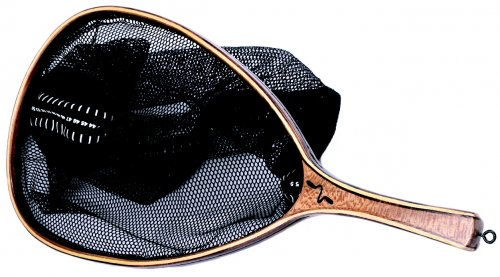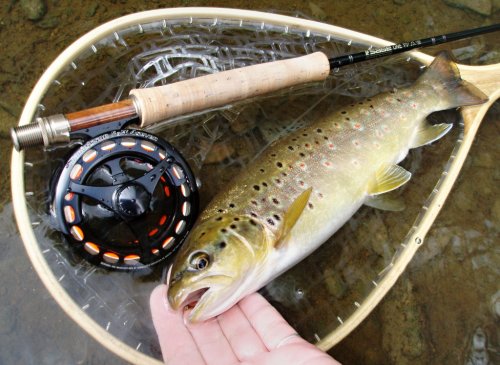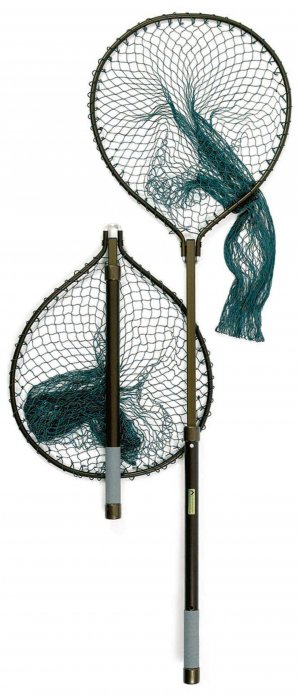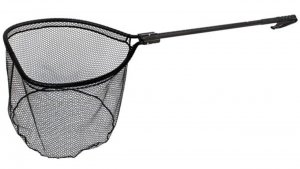The fishing landing net is an important and in the vast majority of fishing areas also a mandatory part of fishing equipment (Czech Republic). In normal fishing, it is not very necessary in most cases, on the contrary, it could be said that it can sometimes be a nuisance. That is why there are often discussions about whether it should be in mandatory equipment at all, etc. In a fisherman's life, however, there are times when a reliable landing net is an absolute necessity, if we do not want to lose a trophy fish, or we do not want to harm it with careless handling! In this my next GUIDE, I have prepared for you a division of all types of fly landing nets according to their construction and the most common use!

Fly fishing landing nets have always been among the most elegant types of fishing landing nets simply because the older and traditional types were often made of beautiful solid and subsequently varnished wood "lined" with nets with large knotted meshes, thus fine-tuning the overall perfect sports-gentleman's outfit - A man in a hat who whipped water with extraterrestrial ease in the middle of a clear river!
But times have changed, the poetics of the fly-fishing tradition has slowly disappeared, but the emphasis on quality and the perfect sporting appearance of fly fishers has remained, and this can also be said of fly fishing landing nets, which simply went with the times! Therefore, it can be safely said that landing nets are no longer just - often difficult mandatory fishing gear, which interferes when moving around the river, catches branches and ultimately damages the protective slime on the surface of the fish body - as indicated in the introduction, but a full part fly fisherman's equipment and their functionality, practicality, fish-friendliness and appearance are often handled as intensively as, for example, the selection of a fly rod or reel.

That is why I have created for you a simple division of fly landing nets according to their basic construction parameters, which are in direct connection with their main use in water! Of course, I will not deprive you of the individual benefits of specific types of landing nets and practical tips based on my experience of fishing for freshwater fish in various conditions, in which I always had the mentioned types of landing nets on hand and appreciated their benefits, or I exchanged them after not completely satisfactory experience. for another type more suitable for the given method of fly fishing.
But before we imagine the individual types, I would like to focus on the materials from which fly landing nets and their nets are made, because these are crucial structural elements according to which we can choose landing nets, and we should know all their advantages and disadvantages.
LANDING NET MATERIAL: Nowadays, you will most often come across wooden, aluminum, carbon and special landing net types, which can include, for example, plastic, bamboo or variously combined types of all the mentioned versions! Of course, each material has its advantages and disadvantages, but the manufacturer should always think about the meaningfulness and practicality of the material used, depending on the main use of the landing net. But I will focus on the most commonly used materials and those are wood and aluminum!
Wooden landing nets are therefore mainly river types of short landing nets, which take advantage of the lightness and great floating properties of wood + elegant traditional appearance, which simply belongs to the river fly fishing! Of course, today there are already all-wood landing nets "long - stillwater" with an elongated handle, which can be used when catching large lake trout from the shore and from the boat, but also predatory or carp fish - mostly in combination with a deep silicone net. The disadvantage of wooden landing nets is to some extent their fragility - you can break the wooden landing net, or it can stick over time and under the influence of different temperatures. If you beat its surface treatment (varnish), it can start to soak up water, which can make it difficult or the wood itself may be damaged (mold, etc.)
=> Landing Net With Silicone Net Leichi, Landing Net With Rubber Net Cortland Catch & Release

Aluminum landing nets are very common nowadays, as they are modern / sports and competitive landing nets, which are also very light, sold in various shapes and colors of anodizing and of course - compared to wooden landing nets - it is often possible to change them without any problems. and network type (FENCL). Aluminum frames are often combined with wooden, plastic or carbon handles. Almost all types of fly fishing / fishing landing nets are made of aluminum, so it is a very versatile and proven material.
The aluminum profile - if it is not equipped with a float - is of course not a good swimmer, so if you do not have a landing net well fixed, you can irretrievably "drown" it (personal experience when fishing from a belly-boat - landing net irretrievably lost), due to the softness of this metal you can inadvertently bend the landing net and in case of careless repair, break and of course you have to count on the "peeling" of the colored anodizing over time - in which case, of course, this is not essential and the landing net is fully functional.
=> Landing nets McLean Angling, Fly fishing landing nets FENCL, Landing Net Hanak Competition Champion
TYPES OF LANDING NETS/MESH: Today, 3 main types of landing net nets are used, namely polyester, rubberized and silicone, and each of course has its pros and cons. However, I dare say that all types are very friendly for fish!
Polyester nets are traditional types of black, green gray, etc. nets with different mesh diameters. In my opinion, due to their absence, nodules are very gentle for fish, but their disadvantage is their "softness" - they can be torn or torn by branches, stones, etc., they also absorb water and fish mucus, so they then smell relatively. They also catch hooks and, for example, fish fins (dorsal carp saw), which can also tear the net!
=> Landing Net Hanak Competition Wave
Rubberized nets are simply polyester nets, which are covered with a soft rubber. A huge advantage is the smoothness of the surface of the net towards the fish body / slime and their ability not to absorb water and adverse odors. At the same time, hooks and nothing else are caught in them. As a disadvantage, I find the life of the rubber surface, which cracks and peels after some time and in the most stressed places. In any case, the landing net can be used without any problems.
Silicone nets are very popular and often referred to as Catch & Release types of nets, as they should be as fish-friendly as possible. Their advantage is a very smooth surface of the material, their durability and perhaps even translucency, which does not scare the fish so much when immersed, such as a black net. I find the disadvantages of silicone nets to be their heavier weight, and if they are not deep enough, the fish are able to bounce off them and jump back into the water (ideally). Furthermore, perhaps just the fact that after some time they change color - they turn yellow, or they absorb another color. Personally, I use this type of net only when catching heavy and large carp or predatory fish.
=> Landing Net With Rubber Net Leichi Carbon
Now let's go to the different types of fly landing nets together with their description of the main use and recommendations for fishing.
SHORT "RIVER" LANDING NETS are probably the most commonly used types of landing nets among fly fishermen. These are medium-sized and variously shaped landing nets with shorter handles, the frame of which is either all-wood or combined from aluminum together with a wooden or plastic / other handle. There are, of course, other types of materials, as I wrote above, but wood and aluminum are the most common. With these landing nets we will encounter almost all types of shallow to medium-deep nets and their biggest advantage is that they are always by your hand during fishing! You can hang landing nets of this type, for example, on a fly vest with a carabiner or magnetic holder, or fasten them to a belt, backpack, etc., without interfering with you in any way. As soon as the fish that is worth landing takes over, you reach for the landing net and you are ready to net the fish without any problems! This type of landing net is designed mainly for situations where you can reach your catch - for example, when fishing from the low shore. The moment you fish in not entirely friendly terrain - for example from high shores, or behind higher aquatic plants (on still water), it is more appropriate to use a landing net with an extended handle and ideally with a larger frame diameter, and thus the following types of fly landing nets.
My current personal favorites are the top-processed Fly Fishing Landing Net With Magnet Fencl Nature L, mainly for catching river salmonids (size M and L) and larger non-salmonid fish (size XL)! From the point of view of the traditional way of river fly fishing, the Landing Net With Rubber Net Cortland Catch & Release with a silicone net is an excellent partner for dry fly fishing evening with raising trout.
LONG "STILLWATER" LANDING NETS are of course most often used when fishing on still water from the shore and boats. These are fixed types of landing nets that the fisherman has placed somewhere near him (either on the shore next to the fishing place or leaning on the edge of the boat so that they are always by his hand) consisting of a landing net head and either a standard or telescopic rod. The heads have different shapes, whether they are circles, ellipses or modified shapes of classic fly fishing river landing nets, but one thing is crucial, and that is their size, which is larger than with classic river short landing nets. When fishing on still water, you will most likely catch much larger fish - whether salmonid or otherwise - but you will also want to bring such fish with much more confidence above the landing net mesh, which is often not entirely feasible with a smaller head diameter. Due to the fact that you will often fish in various terrains during lake fly fishing, I recommend completing the landing net head with a telescopic rod, the length of which is not fixed, but adaptable to the given conditions! You definitely don't want to get into a situation where you can't net a nice fish, for example, because you can't reach it through a dense coastal vegetation with a landing net!
Personally, for fishing on still water, I most often use a combination of landing net head with rubberized net and telescopic landing net rod for landing net heads, or - in case of clear shore, or in case of wading landing net with extended handle with extended fixed handle, with which we they also picked up large lake trout by boat catching on English reservoirs!

COMBINED - FOLDING TELESCOPES - LANDING NETS are excellent in that they can be used both for fishing on the river and for fishing on still water - they are very versatile and ready for any situation. Thanks to the lowering of the head to the handle, the result does not take up much more space, for example on your back or clipped at your side, than classic river nets, and at the moment of need to net the catch you simply unclip the landing net, open it with a simple swing or lift the telescopic handle and you can pick up your catch. Of course, such landing nets are also great when traveling, as they are much more compact than long unfolded landing nets, which you do not always want to unscrew back on the head and rod. In smaller sizes (Landing Net Mclean Hinged Sprung Telescopic 510), these types of landing nets are excellent for river fishing from higher and less accessible banks, for example on deep pools, into which it would still not be realistic to penetrate. In larger sizes / diameters, they are great for fishing in still waters, whether from the shore or from a boat, or when stalking predatory fish.
Personally, I like to use these types of landing nets just for the hunting style of fishing - stalking carp and predatory fish, when I attach the folded landing net to my waist and at the moment when I need to catch the fish, unclip the landing net, open it and possibly extend it to get closer to the fish in open water. ! My favorite type is the Landing Net Mclean Weigh-Net Hinged Telescopic 130, which also has a sufficiently deep and spacious rubberized net that can hold a really big fish if necessary!
* Having mentioned the depth of the net, I have to add one of my observations. I don't like landing nets with too deep nets for stillwater trout fishing, because in them trout are "chased" unnecessarily long before they are released - in a situation where the landing net is immersed in water, the nets sag and the fish has enough space to escape your attempts to catch it from the landing net. In my opinion, the ideal net depth for lake landing nets is max. 40 cm. The depths of the nets of 50+ cm are more for larger predatory and carp fish, the catched size of which is usually around 50/60 cm and more!

TROPHY & BOAT FISHING LANDING NETS are no longer so fly fishing landing nets, but they are clearly very important in heavier fly fishing. These landing nets should be as strong as possible, reliable constructions and nets from which even the largest fish will not escape and in any case will not be injured in any way. Of course, we must also take into account the higher weight of such landing nets, but since fishing for large fish is a demanding discipline, the weight of a large and strong landing net should not be tossed by anyone! The handling of a really big fish is very demanding and if the trophy fish does not want to cooperate with us, it is not a problem for it to smash, for example, fragile equipment in a while. Therefore, in addition to all other and main fishing equipment, a sturdy landing net is also extremely important, which is then as safe and comfortable as possible for the trophy fish!
At a time when I didn't take the issue of a quality landing net too seriously and took one larger universal landing net for most of my fishing trips, I experienced, for example, a situation where a large carp literally tore my polyester net at this landing net more than twice - he simply pierced her head and sailed on free water. The second time I net him, he tore the net in another place! :-)
Due to such experience, I am glad that I now use for this purpose the most reliable Landing Net Mclean Salt Water Measure & Weigh XL R703, which is very strong and with a deep rubber net, which, for example, does not even jam the dorsal fins of trophy carp or large and sharp pike teeth. I must admit that the landing net is relatively heavy, but I do not fully experience this during the demanding fishing with the AFTMA 9 rod and fighting meter fish!
PRACTICAL ACCESSORIES FOR LANDING NETS are not necessarily necessary, of course, but they are useful if you want to have your landing net securely and practically attached for its immediate and trouble-free use. Such aids that I use myself include, for example, the Net Holster Smith Creek, which I fastened to the belt of my fly fishing hip pack on the left side, and the landing net is here for immediate use! Previously, when I had my landing net inserted only by the belt of my wading pants, it often happened to me that as it moved, it gradually extended and fell to the ground or into the water. Fortunately, I've always found it or dropped it, but not everyone is so lucky and exposing yourself to the potential loss of an expensive landing net is completely useless!
Another and - in my opinion - absolutely necessary accessory of the fly landing net is any cable or string that will also save the landing net from its certain loss in the river, etc. An excellent combination of such a cable together with the magnetic attachment of the landing net to vest, jacket, backpack, etc. is Magnetic Net Holder Fencl For Fly Fishing Landing Nets, from which you can also choose the strength of the magnet - I highly recommend the highest - 6.2 Kg! If you are going to buy a new landing net, there is nothing easier than buying a landing net with this system, which is part of the landing net itself!
REQUEST FOR CONCLUSION: Although this article may seem to you in a "no landing net or shot" style, in most cases it is exactly the opposite! I am definitely not a supporter of regular - "competition" use of the landing net to catch every fish you catch. By no means! I am only for the use of the landing net only in unavoidable cases, when its use for fish is safer than another way of landing - for example, multiple guidance of the fish in the hand in a strong current is definitely not a better solution than one-time and immediate landing and I will not mention other ways of handling fish during its hooking, which unfortunately some fishermen still practice...
If at all possible, do not net smaller and delicate species of fish and remove the fly without contact immediately in the water, larger fish take as far as possible in a wet hand without squeezing the fish in any unnecessary way and prolonging removing your fly from their jaws and for large and heavy fish it is best to net them with landing nets of adequate size and do not take them anywhere above the water where they could be injured!
The landing net is ideally only to help us land/net an "exceptional" fish or, in the most extreme cases! Not to impatiently assist with each fish we catch! ;-)




































